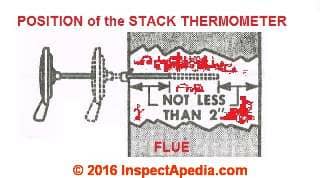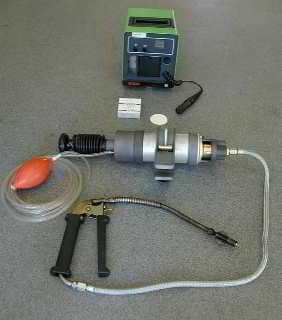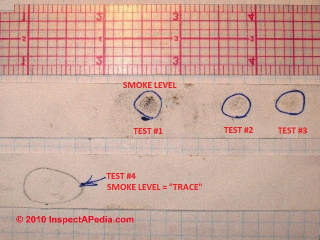 Oil Burner Tests & Adjustments
Oil Burner Tests & Adjustments
How to Measure & Set Oil Burner Combustion Air & Smoke & CO2 or O2Levels
- POST a QUESTION or COMMENT about oil burner performance tests and measurements
Oil burner smoke test which in turn reflects combustion air & temperature adjustment are necessary for safe, efficient and reliable oil burner operation: this article explains and illustrates oil burner smoke testing - a key step in oil burner adjustment for proper operation.
An oil burner flame that is too smoky soots-up the heating system leading ultimately to a no-heat call and a clogged furnace or boiler or water heater.
An oil burner flame that "looks very clean" may in fact be running too hot, wasting fuel, increasing heating costs, damaging equipment, or perhaps even unsafe. This article describes how we measure the oil burner smoke level and describes the proper smoke settings.
This article series answers most questions about central hot water heating system troubleshooting, inspection, diagnosis, and repairs. We describe how to inspect, troubleshoot and repair heating and air conditioning systems to inform home owners, buyers, and home inspectors of common heating system defects.
InspectAPedia tolerates no conflicts of interest. We have no relationship with advertisers, products, or services discussed at this website.
- Daniel Friedman, Publisher/Editor/Author - See WHO ARE WE?
Oil Burner Smoke Test - Indicates Proper Combustion Air, Draft, Burner Adjustment
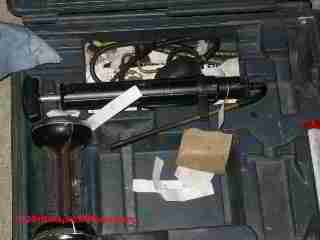 If the oil burner is not working, start your diagnosis
If the oil burner is not working, start your diagnosis
at OIL BURNER INSPECTION & REPAIR.
The basic measurements made by any competent oil heat service technician include the stack temperature, draft, smoke level, and carbon dioxide level (separate discussion
at OIL BURNER CO2 TEST).
These data tell us whether or not the equipment is properly adjusted and operating safely and economically.
Here we explain how we measure the Bachrach or Bosch smoke numbers - a slightly subjective evaluation of the level of smoke or "soot" found in oil burner exhaust flues.
One of these most basic tests performed by an oil heat service technician is the "smoke test" using a strip of filter paper and a pump to sample the oil burner exhaust, measuring the level of smoke in the exhaust. In fact once an oil burner has been installed or just after the oil burner has been serviced, the service technician will usually start her system tuning and adjustment with a simple smoke test.
Our photo (left) shows a traditional smoke testing pump (the black cylinder with a handle at its right end) used for decades. This equipment was produced by Bachrach, an oil burner test equipment manufacturer.
Steps in Conducting an Oil Burner Smoke Level Test
- Get to stable state operating temperature:
The technician allows the oil burner to reach normal operating temperature (perhaps after it has been on for five minutes), - Select a smoke test strip:
A clean white strip of filter paper is inserted into the end of the smoke testing pump.
Watch out: when making fine readings of the smoke level using an oil burner smoke tester, be sure that you are using a new smoke test paper strip or a very clean area on the strip if you're making more than one measurement, and be sure that your fingers are clean of soot when handling the test strip, else you may mistake your own smudges for the smoke reading. - Where to test the smoke level:
The nozzle of the smoke tester is inserted into a 1/4" diameter hole in the flue vent connector pipe, typically just a few inches above the top of the oil-fired heating boiler or furnace. - Pull the smoke sample:
The pump handle is operated - Inspect the smoke spot on the paper:
The filter strip is removed and the "blackness" of the sample spot is compared with a scale that rates the soot level. An experienced oil heat service technician simply looks at the black or gray spot on the filter paper.
WARNING UNSAFE CONDITIONS: as we have written in several articles, it is impossible to do a good job cleaning and servicing oil fired heating equipment without getting dirty.
But if you put your sooty fingers all over the filter paper before or after conducting a Bachrach / Bosch smoke test, then soot from your hands will get onto the filter paper and you may mistake a 0 smoke reading as a 1 or 2 level smoke.
Don't touch the smoke sample test area with your dirty fingers.
 Zero-level smoke in a Bachrach / Bosch test is actually "too clean" for most oil burners, and means that there is too much air entering the oil burner, causing the burner to operate too hot, and sending too much heat (and thus the money the homeowner spent on heating oil) up the chimney.
Zero-level smoke in a Bachrach / Bosch test is actually "too clean" for most oil burners, and means that there is too much air entering the oil burner, causing the burner to operate too hot, and sending too much heat (and thus the money the homeowner spent on heating oil) up the chimney.
The correct smoke level is just a "trace" of smoke on the filter paper, a level of 1 is good.
A smoke level of "1" or "2" is normal. In our oil burner smoke test results photo (at left) you can see four smoke test samples. Sample #1 is certainly too dirty, sample #2 and sample #3 are a bit high, though we might accept sample #3.
Test #4 is just slightly above zero or "trace level" of smoke and is a reasonable setting before we further set combustion air to the target CO2 or O2 level.
Watch out: sorry for the labels in our photo at left: Don't mix up our sample test numbers #1 - 4 with smoke level values = 0,1,2,3, etc.
A smoke level of 0 means there is no black soot visible on the filter paper.
The Bachrach or Bosch smoke number scale ranges from 0 (no detected smoke) to 9 (solid black). In addition to using the hand operated smoke pump illustrated here, some electronic combustion analyzers can also produce a smoke level number. [Click any image or table to see an enlarged, detailed version.]
Higher smoke levels indicate that the system is operating too "dirty" or smoky. High levels of soot in the oil burner exhaust mean that the system will deposit soot more rapidly inside of the furnace or boiler heat exchanger, interfering with heat transfer into the building heating air or water, and thus increasing system operating cost - meaning higher heating bills and more frequent oil burner service needed.
Very high smoke levels may indicate or even cause plugging up of the furnace or boiler, leading to improper oil burner operation, an unsafe system, and possibly other malfunctions, even a "puffback".
Should we Set The Oil Burner for Zero Smoke?
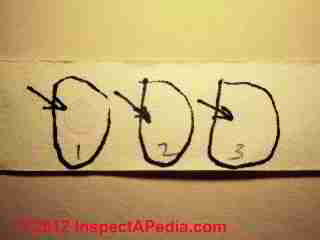 To perform the oil burner "smoke" adjustment correctly and to avoid over-firing or overheating the boiler, as well as to avoid an inefficient set-up that sends too much heat up the chimney, the heating service tech will first set the oil burner for just a trace of smoke (#1 in our photo at left), then s/he will slightly increase combustion air until the trace just vanishes to a zero smoke reading (#2 and #3 in our photo) with the test filter paper and smoke gun.
To perform the oil burner "smoke" adjustment correctly and to avoid over-firing or overheating the boiler, as well as to avoid an inefficient set-up that sends too much heat up the chimney, the heating service tech will first set the oil burner for just a trace of smoke (#1 in our photo at left), then s/he will slightly increase combustion air until the trace just vanishes to a zero smoke reading (#2 and #3 in our photo) with the test filter paper and smoke gun.
Technical note: on some modern oil fired heating systems the oil burner combustion air and oil pressure are adjusted to a standard of zero smoke rather than a trace of smoke.
Watch out: Other measurements including stack temperature, draft, and CO2 are required to properly and safely set up an oil burner.
Typically, for a modern high speed oil burner burning No. 2 fuel oil, you'd set the flame to just a trace of smoke - that is barely above zero, less than 1 on the smoke scale - then you'd open the air shutter until you see 12.0% CO2or 4.5% O2.
Watch out: Don't come at zero smoke from a position of too much combustion air or you won't know what you've got and you may be wasting fuel and overheating the equipment. Thanks to Bob, a heating service technician at Bottini Oil, for this service tip.
Also see COMPLETE COMBUSTION, STOICHIOMETRIC for an explanation of complete fuel combustion and boiler or furnace maximum efficiency.
Oil Burner Smoke Number Standards
While technicians and equipment suppliers commonly refer to a Bachrach smoke number or Bosch smoke number, these smoke measurements are also standardized in ISO 10054
Actually there are at least eleven different smoke level measurement standards. Homan (1985) reports on standardization among these.[5]
The second common test performed by an oil heat technician evaluates the oil burner efficiency by measuring the carbon dioxide level or CO2 level in the oil burner exhaust.
Details of measuring the carbon dioxide level for oil burners, a second key measurement needed for proper setting of oil burner combustion air & operating temperature are now
Combustion Analyzer Recommendations & Sources of Oil or Gas Burner Combustion Testing Kits include Oil Burner Smoke Level Measuring Devices
- Bachrach Inc. provides the Fyrit ® Classic Oil Kit (shown in the case photos shown here) for testing oil or gas burners, as well as a number of other test instruments such as the Fyright® Insight® Plus (electronic), Fyrite Intech®, the ECA450, and the PCA 3 portable combustion analyzer.
Website: http://www.bacharach-inc.com/combustion-test-kits.htm, Bacharach Sales/Service Center 621 Hunt Valley Circle New Kensington, PA 15068-7074 Tel: 724-334-5000 Fax: 724-334-5704 E-mail: Help@MyBacharach.com - Bosch smoke testing & smoke numbers [data needed]
- Hartridge smoke testing & smoke numbers [data needed]
- Uei Test Instruments, UEI 675 combustion analyzer ($775 U.S. Amazon.com), Uei D460 Draft Gauge, Website: http://www.ueitest.com/,
UEI Test Instruments, Portland, OR 8030 SW Nimbus
Beaverton, OR 97008
Tel: 503 644-8723
Tel: 1-800-547-5740
Fax: 503 643-6322
Email: info@ueitest.com
or
UEI Test Instruments, 8030 SW Nimbus Beaverton, OR 97008 Tel: 503 644-8723 Tel: 1-800-547-5740 Fax: 503 643-6322 Email: info@ueitest.com
How does the oil burner tech adjust the Air Shutter on an Oil Burner? Combustion air adjustment procedure.
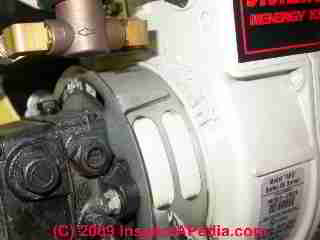 "Set the oil burner smoke level" as we mention in the article above means that the service technician will have to adjust one or more of the following in order to obtain the desired trace of smoke on the smoke test or zero smoke + a specified operating temperature range if that alterative is called for by the oil burner manufacturer.
"Set the oil burner smoke level" as we mention in the article above means that the service technician will have to adjust one or more of the following in order to obtain the desired trace of smoke on the smoke test or zero smoke + a specified operating temperature range if that alterative is called for by the oil burner manufacturer.
At left you can see that the pointer on the air shutter on this Beckett Model AF oil burner is set to an index number of 3 1/2. The oil burner is sensitive to small changes in intake air.
At that 3 1/2 setting you can just barely see an air opening at the top and bottom of the large shutter openings - those two small black areas.
[Click to enlarge any image].
The air intake shutter at the oil burner is adjusted by loosening one or two clamping screws, then rotating the air shutter to a higher index position to increase or to a lower index number to decrease the rate of air flow into the oil burner.
This adjustment is made first, setting the smoke to just a trace above zero, then the technician measures and further adjusts the air shutter, measuring either O2 or CO2 (targets given below) to make further adjustments.
Most newer oil burners such as the Beckett™ series include index marks along the side of the oil burner body and a pointer attached to the oil burner air shutter. There may also be a label affixed to the oil burner OR a table in the oil burner's instruction manual that suggests a recommended intake air shutter position for various oil burner nozzle sizes (in GPH).
Beckett recommends that after you've set the oil burner to give just a trace of smoke using a smoke tester, then you open the air shutter until this level changes (from a presumed slightly higher measurement)
down to 12.0% CO2 or 4.5% O2.
That gives an efficient and seasonally-clean oil burner operation with a slight safety margin without overheating the system.
Watch out: particularly with newer high-speed, higher efficiency oil burners, if there are other air leaks such as around the transformer at the upper rear of the oil burner assembly you may have trouble setting and regulating the desired burner intake air rate.
Be sure that the plate mating the transformer to the oil burner top is flat, not bent, and remember to tighten the screws that hold the hinged-type transformer front end down snugly in place.
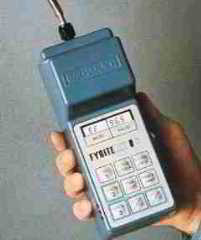 Watch out: while back in the "old days" it was reasonable to "tune" an low speed (1725 RPM) oil burner by eye with a bit of spit and guesswork, that is not the case with modern, high speed (3450 RPM) oil burners. In fact the flame may not even be visible, and spitting on the flue vent connector is no longer an adequate measure of temperature, nor of CO2.
Watch out: while back in the "old days" it was reasonable to "tune" an low speed (1725 RPM) oil burner by eye with a bit of spit and guesswork, that is not the case with modern, high speed (3450 RPM) oil burners. In fact the flame may not even be visible, and spitting on the flue vent connector is no longer an adequate measure of temperature, nor of CO2.
Instead the oil heat service technician must make use of instruments to measure draft, temperature, CO2 or O2 as well as smoke level.
- Other draft controls such as a barometric damper may need adjustment. Typically we look for 0.02" WC (water column) over the fire and 0.04-0.05" WC 5 in the breech, the section of flue vent connector between the top of the boiler or furnace and the barometric damper or draft regulator.
Watch out: The draft in the breech must always be higher than over the fire, otherwise you're running your oil burner in a backpressure condition, causing overheating, damage and unsafe conditions.
If you cannot obtain proper draft measurements chances are that the chimney is blocked (draft too low) or there are openings in the chimney such as an ash pit door left open (draft too high).
See DRAFT MEASUREMENT, CHIMNEYS & FLUES - CO2 or O2 are measured both to obtain a picture of how efficiently the oil burner is operating and also how safely. Typically we'll see a tuned oil burner running at about 12-13% CO2 or at about 2.5-4.5% O2.
See OIL BURNER CO2 TEST - The oil burner nozzle size (in GPH) may need to be changed.
See OIL BURNER ELECTRODES - The combustion air supply to the oil burner or to the room where it is located may need to be corrected if it's inadequate.
See COMBUSTION AIR REQUIREMENTS - A problem with the chimney: leaks, blockage, wrong or missing rain cap, etc. may need to be corrected to obtain adequate draft.
See CHIMNEY INSPECTION DIAGNOSIS REPAIR - More rarely, a draft inducer fan may be required if draft is inadequate and you've established that the cause is not a defect such as chimney leaks or blockage.
See DRAFT INDUCER FANS
- Exhaust gas temperature should always be measured in the breech as part of an oil burner tuneup, as too high a temperature tells us that we're sending oil costs up the chimney unnecessarily and that the system may be unsafe, while too-low a stack temperature may indicate inadequate combustion.
Heating sources such as Beckett, cited below, provide oil burner tuneup details including an oil burner net efficiency table relating stack temperature and CO2 or O2 levels measured in the breech.
For example at a too-low O2 level of just 1% and a too-high stack temperature of 600 °F, the oil burner will be running at about 80.6% efficiency: about 20 cents of the heating oil dollar is going up the chimney. If we tune that system to an O2 level of 4% and a stack temperature of 350 °F, the efficiency will improve to about 85.1%.
Now about 15 cents of the heating oil dollar is going up th chimney: a reduction of the original flue loss by 25% and reduction in annual heating cost by about 6%.
Watch out: high stack temperatures, say over 500 °F and certainly over 600 °F probably mean that the heat exchanger in the boiler or furnace is soot-clogged: you're not transferring heat from the combustion gases into the boiler water or building air; instead you're sending it up the chimney. At 800 °F and 12% CO2 you're sending 18 cents on the dollar up the flue.
One should also worry about the increased risk of a building or chinney fire when operating a heating system at abnormally high temperatures.
Watch out: direct-vent oil fired heating equipment will not use a conventional chimney nor barometric damper, but the combustion air, air shutter, and other oil burner adjustments are still required for proper and safe operation.
See DIRECT VENTS / SIDE WALL VENTS
Smoke Tests, Smoke Numbers, Smoke Testing Equipment for Heating Systems
- Aetholometers: a measure of smoke output or a "smoke number" that describes the optical properties of smoke.
- Bosch smoke units (BSUs) smoke testing & smoke numbers - shown in our photo above, A Bosch smoke meter illustrated in the research cited just below.
Dabill, D. W. Controlling and monitoring exposure to DIESEL ENGINE EXHAUST EMISSIONS in non-coal mines [PDF] Health and Safety Laboratory, 2005. Prepared by the Health and Safety Laboratory
for the Health and Safety Executive 2004, retrieved 2017/10/21, original source http://www.hse.gov.uk/research/rrpdf/rr252.pdf - [5] Homan, H., "Conversion Factors among Smoke Measurements," SAE Technical Paper 850267, 1985, doi:10.4271/850267
Abstract from SAE:
A set of smoke measurement conversion equations are derived. The equations convert any of eleven smoke measurements to the other ten measurements.
The eleven measurements are: Bosch, SAE, and ASTM (Bacharach) smoke numbers, Hartridge opacity, PHS opacity, Calesco model C107 opacity, extinction coefficient, transmittance, opacity, fraction of fuel carbons converted to smoke, and mass fraction of smoke in the exhaust gas.
These eleven smoke measurement methods are described along with a general explanation of the consonance of smoke measurement methods, which allows one to derive equations for interconverting them. A FORTRAN program is listed which performs the conversions.
The predictions of the program are shown to be within the scatter of published experimental data. However, published experimental data varies by as much as a factor of two.
The conversion equations enable experimenters to choose a smoke measurement method which is sensitive to expected smoke concentrations. - retrieved 10/24/2013, original source http://papers.sae.org/850267/ - Filter Smoke Number (FSN)
- Hartridge smoke testing & smoke numbers [most used to examine exhaust in diesel engine work].
A Hartridge smoke test value of 0 indicates perfect "combustion" or "transmissin", or zero opacity.
A Hartridge smoke units (HSUs) a test value of 100 indicates total absorption, or complete opacity. For Hartridge Smoke Units (HSU) technically this measurement is referenced to a transmission length of 430mm, at 100°C and atmospheric pressure. Values in between are not linear with respect to actual light absorption. Reference https://www.physicsforums.com/threads/what-is-hartridge-smoke-unit-hsu-for-diesel-engine-emission.294835/ - Smoke Factor (SF) used by ESPH to describe a remote smoke level sensor result:
the ratio of exhaust opacity to the amount of fuel being burned at the time of measurement.
Black diesel smoke with an SF of 1 means that 1% of the fuel mass is passing through the combustion process to be emitted as particulate matter (PM). - Also see OIL BURNER CO2 TEST where both oil and gas fueled test equipment are described
The articles at this website describe how to recognize common oil-fired heating appliance operating or safety defects, and how to save money on home heating costs.
Oil Burner Settings (Typical)
Standard Oil Burner Settings & Measurements |
Oil Burner Type | ||
| Heating Oil Combustion Indicator | Non-Flame Retention | Flame Retention | Details |
| Carbon dioxide (CO2) | ≤200 ppm | ≤ 200 ppm | OIL BURNER CO2 TEST |
| Efficiency, Steady State SSE % |
≥ 75% | ≥ 80% | |
| Excess Air | ≤ 100% | ≤ 25% | |
| Draft: over fire (negative) Atmospheric Venting |
–.020 IWC or –5 Pa. |
> –.020 IWC or > –5 Pa. |
DRAFT REGULATOR, DAMPER, BOOSTER |
| Draft, positive pressure burner, atmospheric chimney (natural draft), + barometric damper |
- | 0.020 to 0.120 IWC 5 to 30 Pa. 1 |
|
Smoke Level |
≤ 2 | ≤ 1 | OIL BURNER SMOKE TEST |
| Oil Pressure | ≥ 100 psi | ≥ 100–150 psi 1 | OIL BURNER FUEL UNIT |
Notes to the table above
- Check Manufacturer's specifications for the specific oil burner brand & model & heating equipment that it serves
- These data points require that other oil burner adjustments have already been properly set to manufacturer's specifications including
Combustion air supply set based on smoke, Co2 or O2 & temperature measurements
Electrode settings (gap, angle, space ahead of nozzle orifice)
Thermostat wiring, heat anticipator setting
Fuel unit (oil pump pressure) set to manufacturer's specifications
Oil burner nozzle: proper type, pattern, gph
Transformer voltage is normal (not normally adjustable on residential burners) - Beckett, PROPER OIL BURNER ADJUSTMENT [PDF] Beckett Corporation 38251 Center Ridge Rd, North Ridgeville, OH 44039 USA, Tel: (800) 645-2876, retrieved 2016/10/09, original source https://www.beckettcorp.com/support/tech-bulletins/proper-burner-adjustment/
- EPA, GUIDELINES for BURNER ADJUSTMENTS of COMMERCIAL OIL-FIRED BURNERS, [PDF] (1976) U.S. EPA, Oil-burner adjustment procedures to minimize air pollution and to achieve efficient use of fuels, retrieved 2022/07/21, original source: https://nepis.epa.gov
- Danfoss, DANFOSS BURNER COMPONENTS SERVICE MANUAL [PDF] (2012) also see the company's website: burner.danfoss.com
- Also see COMPLETE COMBUSTION, STOICHIOMETRIC for an explanation of complete fuel combustion and boiler or furnace maximum efficiency.
...
Reader Comments, Questions & Answers About The Article Above
Below you will find questions and answers previously posted on this page at its page bottom reader comment box.
Reader Q&A - also see RECOMMENDED ARTICLES & FAQs
On 2019-12-27 by danjoefriedman (mod) - If my smoke level is zero what should my co2 level be
Robert
Although you're right that changing the combustion air volume will change the smoke level, the smoke level itself will not directly translate into a specific CO2 level.
Typically, for a modern high speed oil burner burning No. 2 fuel oil, you'd set the flame to just a trace of smoke - that is barely above zero, less than 1 on the smoke scale - then you'd open the air shutter until you see 12.0% CO₂ or 4.5% O₂. Beckett points out that at that point if you check the smoke level again it ought to look like "zero" on the scale.
Take a look also at the stack temperature, oil burner fuel unit pressure level, nozzle size and spray pattern and how those match to the combustion chamber design, cleanliness of the heat exchanger and stack (sooty pushes up stack temperature), draft, etc.
A nice summary of these settings is given by Beckett at PROPER OIL BURNER ADJUSTMENT [PDF] available here at
https://inspectapedia.com/heat/Oil-Burner-Adjustment-Targets-Beckett.pdf
Original source: Beckett Corporation, https://www.beckettcorp.com/support/tech-bulletins/proper-burner-adjustment/
On 2019-12-26 by Robert
If my smoke level is zero what should my co2 level be
On 2019-12-26 by Robert
Of I set the smoke test to 0/1 then when I adjust the air flow again for the co2 11.5 and co at 5.5 will my smoke test figure not to up
On 2019-11-16 by (mod) - oil burner air shutter setting number?
Tim
If you are asking what number, on the scale cast into the side of some oil burner motors, to which the pointer on the air shutter for combustion air intake should point, start with the number found on a tag right on the oil burner itself, or in the oil burner manual.
In another approach the technician adjusts to see just a trace of smoke at the flame, then, e.g. for a typical Beckett burner, she'll measure CO2 and then open the shutter to drop the CO2 by 1 or 2 percentage points.
I'm not sure what you mean by "automizing" settings. That's not word I know.
On 2019-11-16 by Timothy
What number should it be at for the correct flow of air on an oil burner automizing settings
On 2017-12-03 by (mod) - blue/white smoke coming out of my chimney
No that's not normal for an oil burner operation, you should see essentially nothing at the chimney top. The safest procedure would be to turn off the heating system and call for repair. When an oil burner is running producing lots of smoke and such there's a danger of a puffback explosion.
On 2017-12-02 by norm
i saw blue/white smoke coming out of my chimney is that normal
On 2016-12-30 by (mod) - oil burner flame color & visible smoke
Oil burner flames are always yellow.
There should however be no visible smoke, and further, a properly-conducted smoke test - see the article above where you'll see that the actual smoke test should show either just a trace of smoke (older oil burners) or on some new set-ups, "0" smoke.
On 2016-12-30 by DENNIS LOCKARD - what color should the flame
what color should the flame be in a burnham oil boiler
On 2016-02-06 by (mod) - if you set the burner too hot
Jason: if you set the burner too hot - too much combustion air, you're sending heat and your heating dollars up the chimney even though you are minimizing the smoke and thus the soot accumulation.
That's why a trained service tech does not look for "zero" on the smoke test but rather a "trace" of smoke. The temperature and CO2 level will confirm proper burner operation.
On 2016-02-04 by jason
i just want to adj. my oil burner to keep the least amt. of soot acumilating.
On 2015-11-19 by (mod) -
R Mass
Check for
water leaking into the combustion chamber if you are testing a hydronic or steam boiler
On 2015-11-18 by R mass
Why do I get moisture on my smoke test strip when I try to adjust the air to smoke number 1 or 0
...
Continue reading at OIL BURNER CO2 TEST where we discuss oxygen O2 and carbon dioxide CO2 settings for an oil burner, or select a topic from the closely-related articles below, or see the complete ARTICLE INDEX.
Or see these
Recommended Articles
- AFUE DEFINITION, RATINGS
- CHIMNEY INSPECTION DIAGNOSIS REPAIR including backdrafting or blocked flue
- COMBUSTION AIR REQUIREMENTS
- COMPLETE COMBUSTION, STOICHIOMETRIC
- DRAFT MEASUREMENT, CHIMNEYS & FLUES
- DRAFT REGULATOR, DAMPER, BOOSTER
- OIL BURNER INSPECTION & REPAIR - home
- BOILER / FURNACE ROOM TROUBLE SIGNS
- OIL BURNER VISUAL INSPECTION
- OIL BURNER OPERATING TROUBLE
- OIL BURNER INSIDE TROUBLE
- OIL BURNER CO2 TEST
- OIL BURNER ELECTRODES
- OIL BURNER NOZZLE GUIDE
- OIL BURNER SMOKE TEST
- OIL BURNER WONT RUN - Diagnostic Steps - what to check in what order
- OIL BURNERS - home
- PRESSURE & TEMPERATURE SETTINGS, CONTROLS
Suggested citation for this web page
OIL BURNER SMOKE TEST at InspectApedia.com - online encyclopedia of building & environmental inspection, testing, diagnosis, repair, & problem prevention advice.
Or see this
INDEX to RELATED ARTICLES: ARTICLE INDEX to HEATING OIL, OIL BURNERS, OIL FIRED HEATERS, OIL TANKS
Or use the SEARCH BOX found below to Ask a Question or Search InspectApedia
Ask a Question or Search InspectApedia
Try the search box just below, or if you prefer, post a question or comment in the Comments box below and we will respond promptly.
Search the InspectApedia website
Note: appearance of your Comment below may be delayed: if your comment contains an image, photograph, web link, or text that looks to the software as if it might be a web link, your posting will appear after it has been approved by a moderator. Apologies for the delay.
Only one image can be added per comment but you can post as many comments, and therefore images, as you like.
You will not receive a notification when a response to your question has been posted.
Please bookmark this page to make it easy for you to check back for our response.
IF above you see "Comment Form is loading comments..." then COMMENT BOX - countable.ca / bawkbox.com IS NOT WORKING.
In any case you are welcome to send an email directly to us at InspectApedia.com at editor@inspectApedia.com
We'll reply to you directly. Please help us help you by noting, in your email, the URL of the InspectApedia page where you wanted to comment.
Citations & References
In addition to any citations in the article above, a full list is available on request.
- [2] Beckett Corporation, 38251 Center Ridge Rd., North Ridgeville, OH 44039 440-327-1060 Email: sales@beckettcorp.com supplies residential and commercial oil burners for boilers, furnaces, and water heaters - see www.beckettcorp.com/
- [3] Thanks to Bottini Fuel service. Bottini Fuel is a residential and commercial heating oil distributor and oil heat service company in Wappingers Falls, NY and with offices in other New York locations. Bottini Fuel, 2785 W Main St, Wappingers Falls NY, 12590-1576 (845) 297-5580 more contact information for Bottini Fuel
- [4] Audels Oil Burner Guide, Installation, Servicing, Repairing, Frank D. Graham, 1947 edition (obsolete, out of print). See Brumbaugh, James E. Audel HVAC Fundamentals, Volume 2: Heating or see various versions of this guide available in editions from 1947, 1950, 1955, 1958, 1959, 1962, 1965, 1967, and at prices from around $3.00 to nearly $70.00 - useful for simple, clear, but not current, explanation of how heating equipment works. The original retail price was $1.00. Used copies are available
- [4a] Brumbaugh, James E., Audel HVAC Fundamentals, Volume 2: Heating, Audel [J Wiley]; All New 4th Edition edition (July 2, 2004) ISBN-10: 0764542079 ISBN-13: 978-0764542077
- Audels Oil Burner Guide, Installation, Servicing, Repairing, Frank D. Graham, 1940's edition (obsolete). Updated versions of this guide are available in various editions, 1947, 1950, 1955, 1958, 1959, 1962, 1965, 1967, and at prices from around $3.00 to nearly $70.00 - useful for simple, clear, but not current, explanation of how heating equipment works. The original retail price was $1.00. Used copies are available
- Domestic and Commercial Oil Burners, Charles H. Burkhardt, McGraw Hill Book Company, New York 3rd Ed 1969.
- "Residential Steam Heating Systems", Instructional Technologies Institute, Inc., 145 "D" Grassy Plain St., Bethel, CT 06801 800/227-1663 [home inspection training material] 1987
- Boilers, Boiler Conversions, James E. Brumbaugh, ISBN 0-672-23389-4 (v. 1) Volume II, Oil, Gas, and Coal Burners, Controls, Ducts, Piping, Valves, James E. Brumbaugh, ISBN 0-672-23390-7 (v. 2) Volume III, Radiant Heating, Water Heaters, Ventilation, Air Conditioning, Heat Pumps, Air Cleaners, James E. Brumbaugh, ISBN 0-672-23383-5 (v. 3) or ISBN 0-672-23380-0 (set) Special Sales Director, Macmillan Publishing Co., 866 Third Ave., New York, NY 10022. Macmillan Publishing Co., NY
- Installation Guide for Residential Hydronic Heating Systems
- Installation Guide #200, The Hydronics Institute, 35 Russo Place, Berkeley Heights, NJ 07922
- The ABC's of Retention Head Oil Burners, National Association of Oil Heat Service Managers, TM 115, National Old Timers' Association of the Energy Industry, PO Box 168, Mineola, NY 11501. (Excellent tips on spotting problems on oil-fired heating equipment. Booklet.)
- In addition to citations & references found in this article, see the research citations given at the end of the related articles found at our suggested
CONTINUE READING or RECOMMENDED ARTICLES.
- Carson, Dunlop & Associates Ltd., 120 Carlton Street Suite 407, Toronto ON M5A 4K2. Tel: (416) 964-9415 1-800-268-7070 Email: info@carsondunlop.com. Alan Carson is a past president of ASHI, the American Society of Home Inspectors.
Thanks to Alan Carson and Bob Dunlop, for permission for InspectAPedia to use text excerpts from The HOME REFERENCE BOOK - the Encyclopedia of Homes and to use illustrations from The ILLUSTRATED HOME .
Carson Dunlop Associates provides extensive home inspection education and report writing material. In gratitude we provide links to tsome Carson Dunlop Associates products and services.


